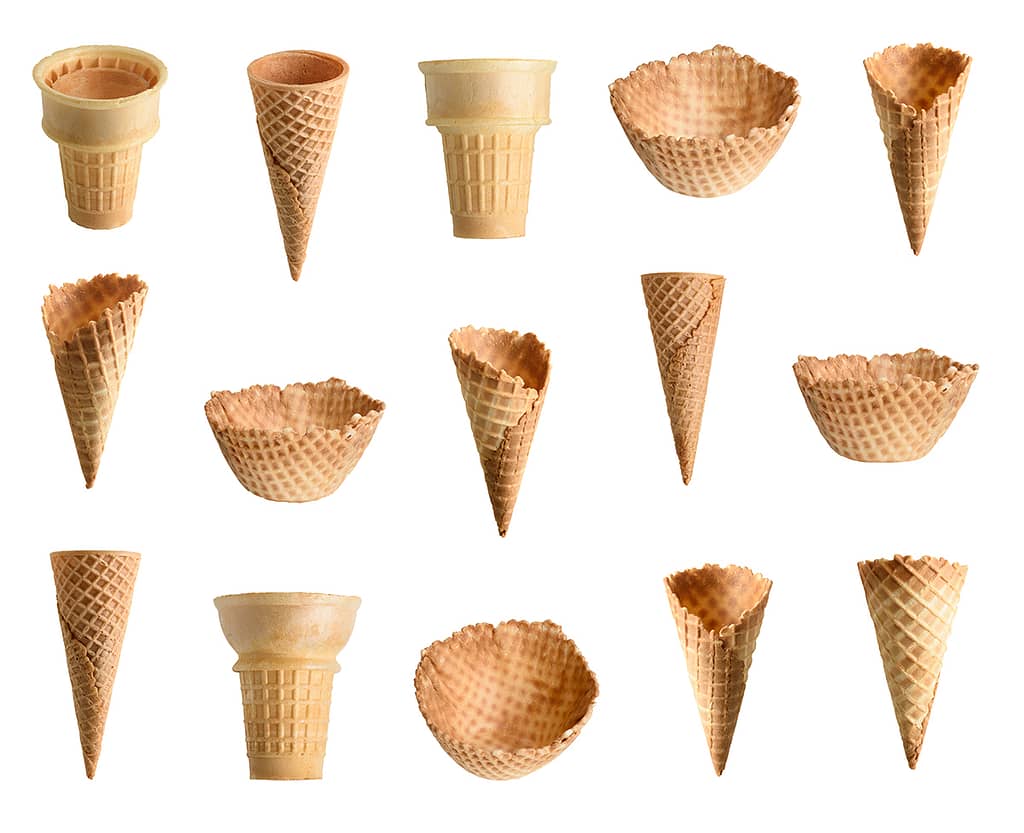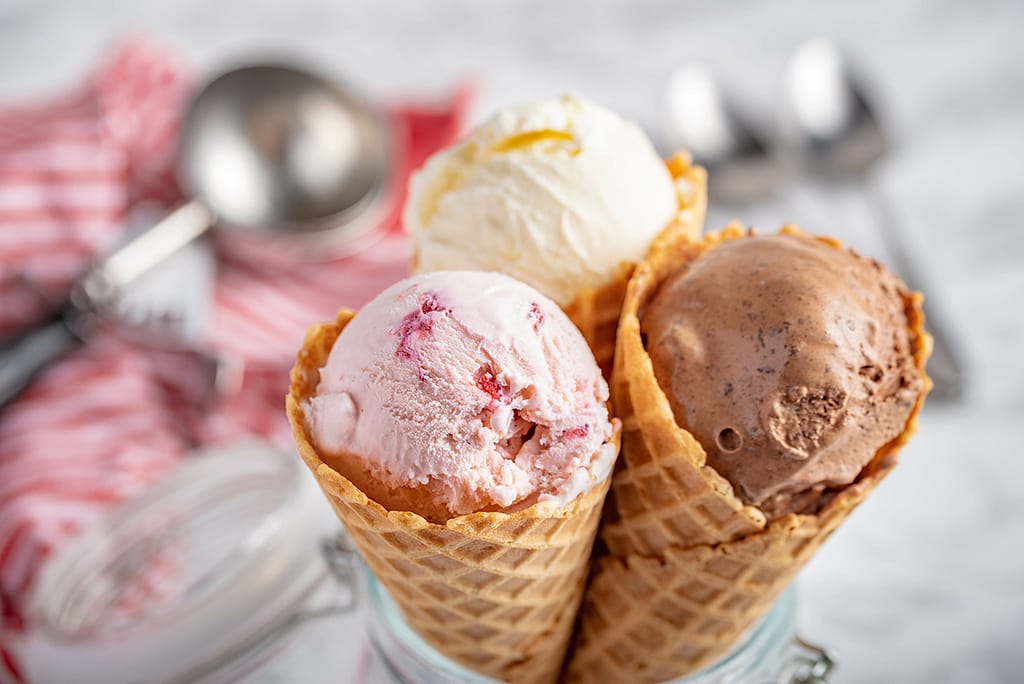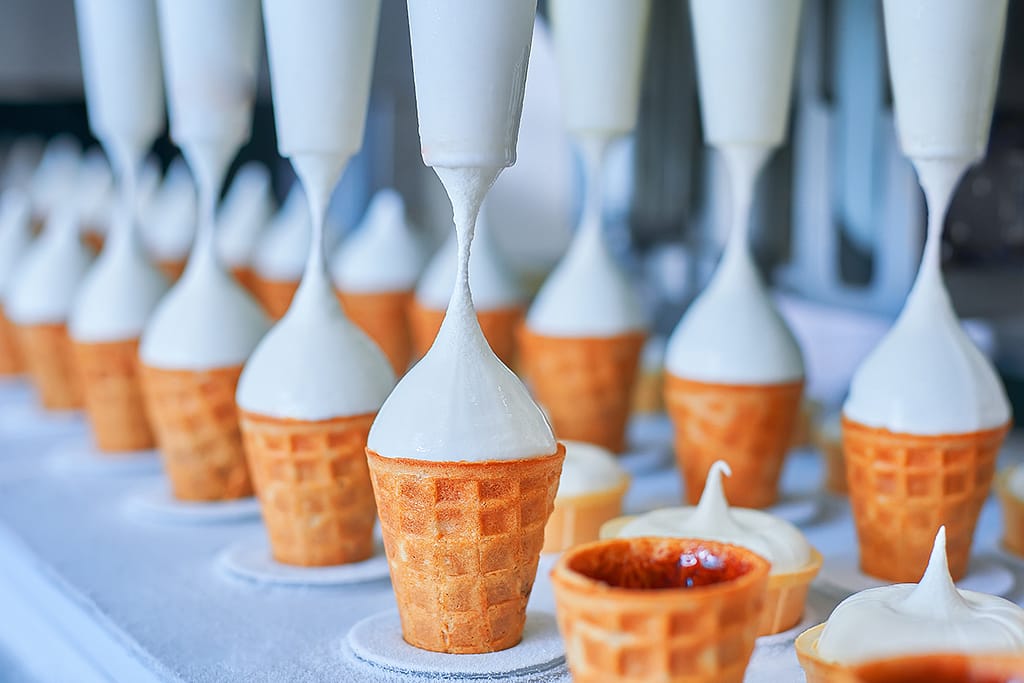Who doesn’t love the delightful experience of indulging in a delicious ice cream cone on a hot summer day? The history of this quintessential treat is as rich and fascinating as the creamy dessert itself. Dive into the world of ice cream cones, exploring its origins, innovations, and cultural impact, and discover how this simple yet ingenious invention has captivated the hearts and taste buds of generations on Ice Cream Cone Day.
Short Summary
Ice Cream Cone Day celebrates the invention and popularization of various types of ice cream cones.
Pioneers throughout time have shaped the evolution of edible cups, leading to modern day creations.
The iconic ice cream cone has become a beloved symbol in American culture with an ever growing industry size and innovation driven by changing consumer preferences.
Ice Cream Cone Day: Origins and Celebrations

Ice Cream Cone Day commemorates the invention and cultural influence of the ice cream cone, with a variety of events and promotions hosted by ice cream shops and fans alike. Although the exact origin of the combination of an edible wafer or waffle, the cone shape, and ice cream is uncertain, the ice cream cone has undeniably become a symbol of summertime bliss and a cherished part of our shared history.
Various types of ice cream cones, and edible cups, have emerged over time, including pretzel cones, sugar cones, and chocolate-coated cones. Each unique cone type adds flavor and texture to the ice cream experience, ensuring that there’s always something new and exciting to discover when celebrating the Ice Cream Cone Day holiday!
The Evolution of Edible Ice Cream Cups

Before the invention of the modern ice cream cone, edible ice cream cups were already in the making. In the 19th century, cone-shaped glass utensils and penny licks were employed to serve ice cream. The evolution of edible ice cream cups can be traced from penny licks in Victorian England to baked biscuit cups in France, paving the way for the modern ice cream cone we all know and love.
However, it was the ingenuity and determination of several key individuals who transformed these early edible cups into the ice cream cones we recognize today. Let’s explore the pioneers who shaped the future of ice cream cones and how their contributions led to the flourishing ice cream cone industry.
Penny Licks and Victorian England
During the Victorian era, penny licks were small glass containers used to serve ice cream. These stemmed glasses were an affordable way for people to enjoy a small portion of ice cream, but they had a major drawback. The shared use of penny licks raised concerns about hygiene and the spread of diseases such as cholera and tuberculosis. As a result, penny licks were eventually banned in London.
While the penny lick may have fallen out of favor, the desire for a more sanitary and convenient way to serve ice cream persisted. This led to the development of edible cups, which not only eliminated the need for shared utensils, but also added an extra layer of flavor to the frozen treat. And so, the stage was set for the birth of the modern ice cream cone.
Baking Biscuit Cups in France
In France, the art of baking biscuit cups dates back to the 18th century. These early edible cups gained widespread popularity during the coronation celebration of Louis XVI in 1775. It was Agnes B. Marshall who provided instructions for making special treats called “Cornets with Cream”. These desserts were cone-shaped, constructed from a sweet paste of blanched almonds and flour. The cones were rolled around cornet molds, baked and filled with delicious whipped cream flavoured with vanilla and sugar.
These early French biscuit cups laid the groundwork for further innovations in the world of ice cream cones. As the popularity of these edible cups spread, the stage was set for the emergence of the modern ice cream cone and the pioneers who would bring it to life.
Pioneers of the Modern Ice Cream Cone

The modern ice cream cone owes its existence to the creativity and determination of several key individuals. Italo Marchiony, Ernest A. Hamwi, Abe Doumar, and Frederick Bruckman all played important roles in the development and popularization of the ice cream cone. These pioneers overcame various challenges and seized opportunities to take the simple concept of an edible ice cream cup and transform it into the ice cream cone we know and love today.
Each of these individuals contributed unique innovations and ideas to the ice cream cone’s development, shaping its future and ensuring its lasting popularity. Let’s delve into the stories of these pioneers and their impact on the ice cream cone industry.
Italo Marchiony and His Patent
Italo Marchiony is often credited with inventing the first ice cream cone. Frustrated by the frequent breakage and disappearance of his ice cream-serving glasses, Marchiony came up with an ingenious solution. In 1903, he patented a device for molding, baking, and trimming ice cream cones. This paved the way for mass production and made ice cream cones widely available and affordable.
Marchiony’s patent laid the groundwork for the future of the ice cream cone industry. Despite legal battles and challenges to his patent, Marchiony’s innovative design would ultimately become the foundation upon which the modern ice cream cone was built.
Ernest A. Hamwi and the St. Louis World’s Fair
Ernest A. Hamwi is another key figure in the history of the ice cream cone. At the 1904 St. Louis World’s Fair, Hamwi was selling a waffle-like pastry called zalabis when he noticed the ice cream vendor next to him had run out of dishes. Seizing the opportunity, Hamwi rolled one of his pastries into a cone shape and provided it to the vendor, who then filled it with ice cream. This simple act of ingenuity captured the imagination of fairgoers and helped popularize the ice cream cone across America.
Hamwi’s contribution to the ice cream cone’s history is a testament to the power of creativity and collaboration. By combining his waffle pastries with the ice cream vendor’s product, Hamwi demonstrated that sometimes the best innovations come from unexpected sources and partnerships.
Abe Doumar’s Claim to Fame
Abe Doumar, the founder of Doumar’s, a restaurant known for its homemade waffle cones, also claimed to have invented the ice cream cone at the 1904 World’s Fair. According to Doumar, he came up with the idea after witnessing a vendor run out of paper dishes. In response, he decided to roll up some of his waffle cones to serve the ice cream, and the rest is waffle cone history.
The Doumar family business, which began with Abe’s first ice cream stand in 1905, continues to thrive today in Norfolk, Virginia. Whether or not Doumar was the true inventor of the ice cream cone, his story adds another fascinating layer to the history of this beloved dessert.
Frederick Bruckman’s Mass Production Machine
Frederick Bruckman played a crucial role in the mass production of ice cream cones. He invented a machine that could mold, bake, and trim ice cream cones, making them widely available at an affordable price. This invention revolutionized the ice cream cone industry and paved the way for the wholesaling of ice cream cones.
Bruckman’s machine enabled ice cream cones to be produced on a scale never before imagined, contributing to the ice cream cone’s enduring popularity. By making ice cream cones more accessible to the general public, Bruckman ensured that the ice cream cone would become a cherished part of our collective dessert experience.
The Ice Cream Cone Business Explosion

The ice cream cone business experienced a massive boom following the 1904 World’s Fair. Numerous companies, including the Western Cone Company, and entrepreneurs entered the market, capitalizing on the public’s newfound love for this delightful dessert. Some of the earliest independent entrepreneurs in the ice cream cone business included Stephen Sullivan of Sullivan, Missouri, one of Ernest A. Hamwi’s earliest customers.
Cone production entered the record books in 1924, with a grand total of 245 million. That was an all-time high for the industry. The ice cream cone’s popularity continued to soar, becoming a beloved symbol of summertime and carefree indulgence. As the ice cream cone business expanded, so too did the variety of cones and flavors available to consumers.
Innovations in Ice Cream Cones
Over the years, ice cream cones have seen a multitude of innovations, catering to diverse tastes and dietary needs. Some popular types of ice cream cones include:
The classic waffle cone
The sugar cone
The cake cone
The pretzel cone
The chocolate-dipped cone
The gluten-free cone
The vegan cone
From these options, there’s always something new for ice cream lovers to discover and enjoy.
As the ice cream cone continues to evolve, it remains a beloved part of our collective dessert experience. Let’s explore some of the most notable innovations in ice cream cones, and how they have shaped the way we enjoy this timeless treat.
Waffle Cones and Sugar Cones
Waffle cones and sugar cones offer different textures and flavors for ice cream lovers to enjoy. The waffle cone, with its crispy texture and distinct pattern, provides a satisfying crunch and a visually appealing presentation for the ice cream. On the other hand, the sugar cone offers a sweeter, more subtle flavor and a slightly denser texture.
These two iconic cone types have become staples in the world of ice cream, catering to different palates and preferences. Whether you prefer the satisfying crunch of a waffle cone or the sweetness of a sugar cone, there’s a cone out there to suit every taste and enhance your ice cream experience.
Flavorful and Healthy Options
In recent years, ice cream cones have expanded to include a variety of flavors and even health-conscious options. From classic flavors like chocolate and vanilla to more adventurous options like bacon waffle cones and Fruity Pebbles cones, there’s no shortage of choices for ice cream enthusiasts.
In addition to unique flavors, ice cream cones have also begun to cater to diverse dietary needs. Options such as low-calorie cones, dairy-free alternatives, and cones with added functional ingredients like CBD, protein, fiber, and probiotics ensure that there’s an ice cream cone for everyone, regardless of their dietary preferences or restrictions.
Pre-filled Frozen Treats
Pre-filled frozen treats like Drumsticks, Cornettos, and iced pudding have become popular in recent years, offering convenience and unique flavor combinations. These ready-to-eat ice cream cones come with a variety of ice cream flavors and toppings, making them an easy and enjoyable option for those looking for a quick and delicious treat.
The popularity of pre-filled frozen treats showcases the continued innovation and evolution of the ice cream cone industry. As new flavors, combinations, and packaging options continue to emerge, there’s no doubt that the ice cream cone will remain a beloved dessert choice for generations to come.
Serving Ice Cream: From Street Vendors to Parlors

The way ice cream has been served throughout history has evolved from its humble beginnings as a treat sold by street vendors to the emergence of elegant ice cream parlors. Despite these changes, the ice cream cone has remained a popular and enduring choice for serving this delightful frozen dessert.
The continued popularity of the ice cream cone as a serving vessel is a testament to its simple yet effective design. Whether enjoyed at a bustling fair or in the comfort of an ice cream parlor, the ice cream cone offers a timeless and satisfying way to savor this classic treat.
The Cultural Impact of Ice Cream Cones

The ice cream cone has had a significant cultural impact, becoming a symbol of summertime and childhood memories for many. From its early beginnings as a simple and convenient way to serve ice cream, the cone has evolved into an iconic and beloved dessert choice that transcends generations.
In 2008, Missouri declared the ice cream cone to be the official dessert of the state, further solidifying its place in our collective hearts and history. As a cherished part of American culture and a timeless symbol of joy and indulgence, the icecream cone continues to delight and inspire both young and old, thanks in part to the Missouri Cone Company.
Ice Cream Cones Today: Trends and Future Outlook

Today, the ice cream cone industry is thriving, with various artisanal cones, unique flavors, and sustainable packaging options available to consumers. The global market for ice cream cones is expected to continue growing, with a positive compound annual growth rate (CAGR) and a market size projected to reach multi million dollars by 2029.
As consumer habits and preferences continue to change, the ice cream cone industry remains poised for continued innovation and growth. From new flavors and ingredients to eco-friendly packaging and health-conscious options, the future of ice cream cones is bright and full of delicious possibilities.
Summary
In conclusion, the history of the ice cream cone is a fascinating journey filled with innovation, determination, and creativity. From its humble beginnings as an edible cup to its evolution into an iconic symbol of summertime, the ice cream cone has captured the hearts and taste buds of generations. As we look forward to the future of ice cream cones, we can’t help but feel a sense of nostalgia and delight for this timeless treat that continues to bring joy to our lives.
Frequently Asked Questions
Is there a National Cone Day?
National Ice Cream Cone Day is celebrated annually on September 22nd.
Who created National Ice Cream Cone Day?
National Ice Cream Cone Day was created in 1903 by Italian immigrant, Italo Marchiony, who applied for his patent on September 22nd. He had been making cones to hold ice cream since 1896.
Celebrate National Ice Cream Cone Day by indulging in your favorite flavor of ice cream in a cone. Enjoy the cone’s deliciousness and the ice cream’s creamy goodness, and share the joy of Ice Cream Cones.
Is July 17th National Ice Cream Day?
Yes, July 17th is National Ice Cream Day, as it is the third Sunday of the month and was officially declared by President Ronald Reagan in 1984.
What is the history of Free Cone Day?
Ben & Jerry’s Free Cone Day began in 1979 as a way of showing gratitude to customers for their love and support during the first year of business.
Who is credited with inventing the first ice cream cone?
Italo Marchiony is credited with inventing the first ice cream cone, although other claimants exist.




